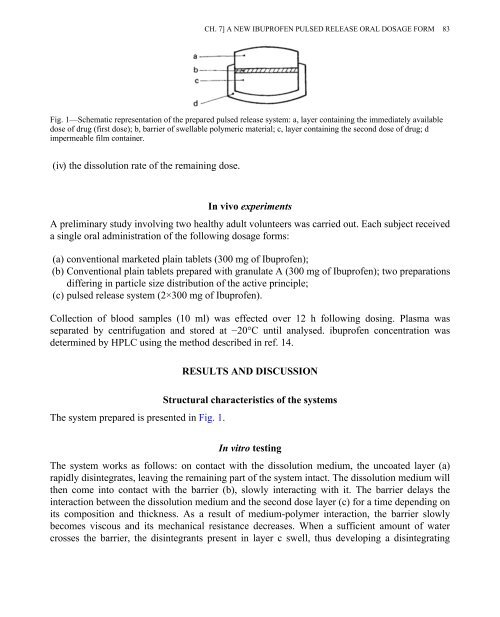Pharmaceutical Technology: Controlled Drug Release, Volume 2
Pharmaceutical Technology: Controlled Drug Release, Volume 2
Pharmaceutical Technology: Controlled Drug Release, Volume 2
You also want an ePaper? Increase the reach of your titles
YUMPU automatically turns print PDFs into web optimized ePapers that Google loves.
CH. 7] A NEW IBUPROFEN PULSED RELEASE ORAL DOSAGE FORM 83<br />
Fig. 1—Schematic representation of the prepared pulsed release system: a, layer containing the immediately available<br />
dose of drug (first dose); b, barrier of swellable polymeric material; c, layer containing the second dose of drug; d<br />
impermeable film container.<br />
(iv) the dissolution rate of the remaining dose.<br />
In vivo experiments<br />
A preliminary study involving two healthy adult volunteers was carried out. Each subject received<br />
a single oral administration of the following dosage forms:<br />
(a) conventional marketed plain tablets (300 mg of Ibuprofen);<br />
(b) Conventional plain tablets prepared with granulate A (300 mg of Ibuprofen); two preparations<br />
differing in particle size distribution of the active principle;<br />
(c) pulsed release system (2×300 mg of Ibuprofen).<br />
Collection of blood samples (10 ml) was effected over 12 h following dosing. Plasma was<br />
separated by centrifugation and stored at −20°C until analysed. ibuprofen concentration was<br />
determined by HPLC using the method described in ref. 14.<br />
RESULTS AND DISCUSSION<br />
The system prepared is presented in Fig. 1.<br />
Structural characteristics of the systems<br />
In vitro testing<br />
The system works as follows: on contact with the dissolution medium, the uncoated layer (a)<br />
rapidly disintegrates, leaving the remaining part of the system intact. The dissolution medium will<br />
then come into contact with the barrier (b), slowly interacting with it. The barrier delays the<br />
interaction between the dissolution medium and the second dose layer (c) for a time depending on<br />
its composition and thickness. As a result of medium-polymer interaction, the barrier slowly<br />
becomes viscous and its mechanical resistance decreases. When a sufficient amount of water<br />
crosses the barrier, the disintegrants present in layer c swell, thus developing a disintegrating

















